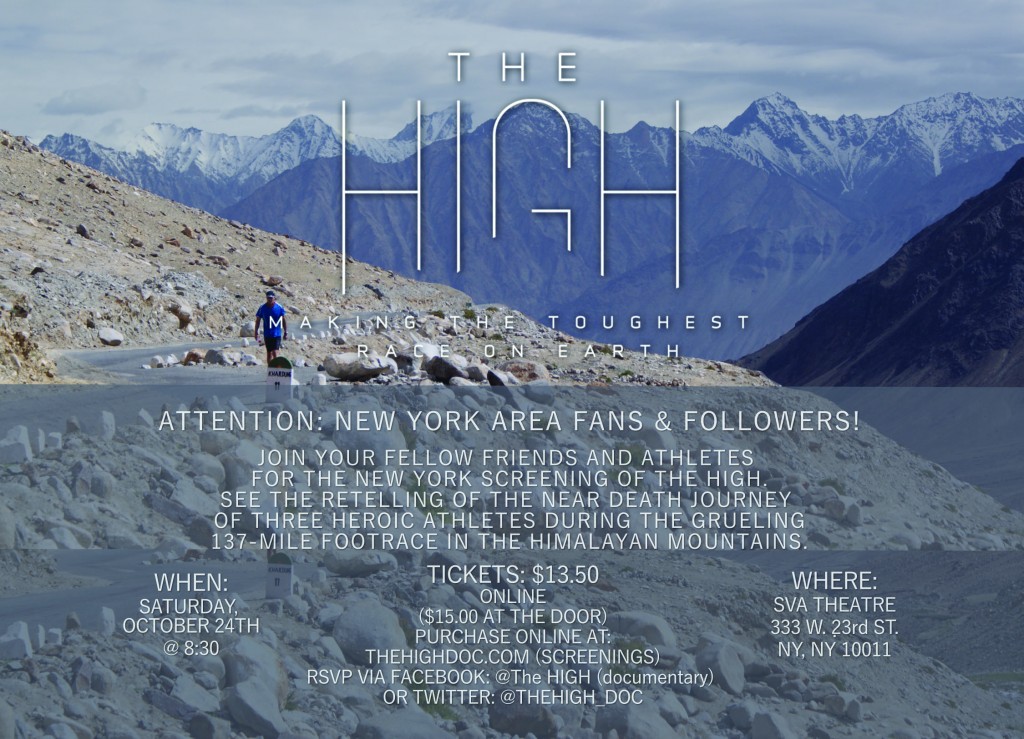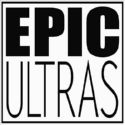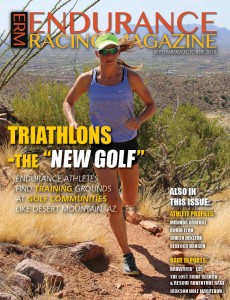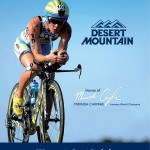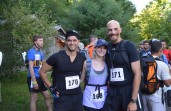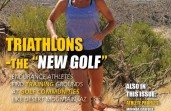Australia’s XPD – Where the Tough Just Need to Survive
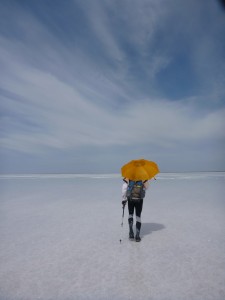 Expedition adventure racing is something of a brutal sport. Competitors typically race through a course of about 500kms over 4-7 days. Throughout the world there are a series of races that make up the toughest and most respected races around, comprising the Adventure Racing World Series. Australia’s one and only expedition race, XPD, stands as a behemoth. It is consistently longer than any other race in the world series, and is renowned as being one of the toughest races of any sort period. The 2013 race, the Geocentric-run XPD covered 750kms with a course duration of up to 9.5 days. My team – Outer Edge Racing – raced for just over six days, trekking, running and mountain biking for about 22hours a day through the Australian outback and Flinders Ranges.
Expedition adventure racing is something of a brutal sport. Competitors typically race through a course of about 500kms over 4-7 days. Throughout the world there are a series of races that make up the toughest and most respected races around, comprising the Adventure Racing World Series. Australia’s one and only expedition race, XPD, stands as a behemoth. It is consistently longer than any other race in the world series, and is renowned as being one of the toughest races of any sort period. The 2013 race, the Geocentric-run XPD covered 750kms with a course duration of up to 9.5 days. My team – Outer Edge Racing – raced for just over six days, trekking, running and mountain biking for about 22hours a day through the Australian outback and Flinders Ranges.
By Navigation Expert, Rohan Kilham
It all began 3 months before the race. I assembled an all-male team and we began a very belated training program focusing on trekking at speed, mountain biking on semi-technical terrain and paddling. It is a salient aspect of all adventure races that the course and maps are revealed just prior to the race start, meaning we were none-the wiser as to which discipline would be the most important.
Six weeks out from the race Sean – the team hard man – pulled out due to work commitments, leaving us to find another member. Queenslander Bec Wilson stepped up, and with only a few weeks to go, we changed our entry to the premier mixed division. It is a curiosity of Adventure racing that the world’s best teams are invariably mixed rather than all male. Indeed in some races only mixed teams are permitted to race – so it was nice to now have a team in the most competitive division.
The race HQ was at Port Augusta, South Africa. Here we attended competency checks, gear checks and briefings. Race bibs were handed out and 20 hours prior to our scheduled departure, we were given our maps. The next day 30 teams from Australia, New Zealand, Papua New Guinea, Japan and Brazil boarded coaches for the race start – the remote Arkaroola.
The race start was preceeded by a ceremony for two adventure racers from team Real Discovery who dies tragically in a sea kayaking accident. After a solemn few minutes on top of Accacia ridge teams followed Real Discovery down to the race start before beginning a 30km rogaine in almost 40 degree heat.
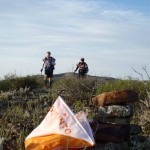 Our team had planned a course through several gorges with some relatively straight forward navigation over several hills and creek-beds. In the stifling heat we slashed our way through sharp undergrowth to the beginning of 20km Gorge. Sweat dried as fast as it soaked my arm-pits and neck, the sun was relentless as it scorched our skin and blistered our lips. After some 4 hours or so we found our first water; a small muddied pool with a dead wallaby on its periphery. We dove in immediately, savoring cold fluid on hot flesh but needed to move on quickly. We ran for a while tussling with the Bivouac Colts and Team Mawson for 3rd place. But as we hit the first transition area, we were in 4th place hot on the heels of the Bivouac Colts.
Our team had planned a course through several gorges with some relatively straight forward navigation over several hills and creek-beds. In the stifling heat we slashed our way through sharp undergrowth to the beginning of 20km Gorge. Sweat dried as fast as it soaked my arm-pits and neck, the sun was relentless as it scorched our skin and blistered our lips. After some 4 hours or so we found our first water; a small muddied pool with a dead wallaby on its periphery. We dove in immediately, savoring cold fluid on hot flesh but needed to move on quickly. We ran for a while tussling with the Bivouac Colts and Team Mawson for 3rd place. But as we hit the first transition area, we were in 4th place hot on the heels of the Bivouac Colts.
We assembled our bikes and headed off into the sunset, but Roland’s chain broke. We fixed the chain and rode through Wooltana station – a flat, arid cattle station of red dirt and bull dust dotted with the pastel greens of saltbush.
The sun slowly set behind us as we rode on, but soon thereafter, Dan began to struggle. He began slurring his words and slowing considerably. He started vomiting and needed a tow. Fortunately, he perked up after an hour or so, but the strain of dehydration and exhaustion were there. We navigated conservatively and moved back to 3rd place. We rode through the night using by lights we travelling some 48kms without a single hill until we found ourselves pushing through soft cattle tracks on bull dust and needed to walk our bikes. After several Km of hiking in bike shoes on the soft red sand we made it to our next transition on the edge of Lake Frome.
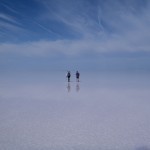 We had no real idea of what this leg would entail. All we knew was that it was a 50+ Km trek on a salt lake. Again we chose a conservative route as we navigated our way to a checkpoint in the middle of several thousand square Km of salty nothingness, before navigating south to the checkpoint. We forged a way though sand dunes and saltbush we hit the lake – a surreal almost 2 dimensional landscape of pure white.
We had no real idea of what this leg would entail. All we knew was that it was a 50+ Km trek on a salt lake. Again we chose a conservative route as we navigated our way to a checkpoint in the middle of several thousand square Km of salty nothingness, before navigating south to the checkpoint. We forged a way though sand dunes and saltbush we hit the lake – a surreal almost 2 dimensional landscape of pure white.
The surface of the lake was like concrete; hard, lightly textured and dead flat. We very carefully set a bearing for our first checkpoint, navigating on a totally moonless night without a single landmark or contour to help. The experience was a little nerve-wracking. It was crucial we stayed on our bearing if we were a little off, we could walk straight past it.
 Eventually morning broke, revealing our position. It was like a surreal dream. On all sides was eternity of flatness. The horizon ended in a 360-degree uninterrupted juncture of pale blue and white – no hills, no landmarks and no clouds. After several more hours of trekking we came across an ‘island’ a patch of sand amidst the white. We rested our feet for a while and assessed our situation. The salt was as abrasive as it was intrusive. It had worn its way into our shoes and socks and was causing some savage blisters. Our toes, heels and the balls of our feet were swollen and sore. Blood oozed from toenails, diluted by the leaking serous fluid of engorged blisters. We taped our feet as best we could, had some breakfast and carried on for another 15hours.
Eventually morning broke, revealing our position. It was like a surreal dream. On all sides was eternity of flatness. The horizon ended in a 360-degree uninterrupted juncture of pale blue and white – no hills, no landmarks and no clouds. After several more hours of trekking we came across an ‘island’ a patch of sand amidst the white. We rested our feet for a while and assessed our situation. The salt was as abrasive as it was intrusive. It had worn its way into our shoes and socks and was causing some savage blisters. Our toes, heels and the balls of our feet were swollen and sore. Blood oozed from toenails, diluted by the leaking serous fluid of engorged blisters. We taped our feet as best we could, had some breakfast and carried on for another 15hours.
As the afternoon overtook us we slowed considerably. Bec had begun to vomit due to heat stroke and we were forced to rest with 10 Kms of white salt to go. Of the 30 litres we had brought we had little more than 5 left. We forced 500 mls down Bec’s throat and dripped small amounts of what was left on her neck, head and chest, trying to cool her down. Eventually we were able to set off again. The challenges didn’t stop however. As we headed south we very quickly came across water. It was so hyper saline that it could not dissolve any of the salt that made up its edge nor could it evaporate easily. With no way of knowing what lay beyond, nor where the waters edge might lie, we forged away straight through it. For 5kms we trapsed through ankle, then knee deep water before arriving at the lake edge. We pulled into the next TA some 20+ hours after beginning. Bec was near collapse, and my mind was shot from focussing on a compass bearing and blank horizon for 20 hours without a break. We agreed to dress our blisters and sleep for 3 hours – a full 24 hours before we had originally planned.
Taking off our shoes was like a horror show. Blisters distorted our feet as if we were deformed. Skin flapped from our toes and heels while blood and serum literally dripped to the ground. Popping our remaining in-tact blisters with a knife was a gruesome task. Like puncturing and overfull sack of pus, they sprayed their contents over our clothes and legs. It was grotesque. The balls of my feet were now detached, my heels – particularly my right – was comprised of a 10 cm flap of wet skin, I had lost the feeling in several toes, some of which were being held together with white tape. The other guys were all missing toenails – casualties of swollen feet – and sported a similar array of skin flaps.
Reality came crashing down. There was very little chance of us finishing a further 140 Kms of trekking with feet like this. Our race was probably over. Earlier on we had jokingly agreed that it would be the finish line or death. Now, with doomed feet, the chance of finishing seemed elusive at best. We agreed that we would go until we physically could go no further. Though we were now racing to survive rather than racing for a place, we agreed we’d keep going until we broke. We were despondent at the thought of pulling out – more so in the knowledge that it would probably be at the beginning of the next trekking leg.
The three hours of sleep we had worked wonders. We got up at about 9 pm and set off several hours later. We had been deliberately slow, having given up on being competitive. However it seemed as though some sort of miraculous recovery was underway. Though we hobbled in pain in our bike shoes, once we were up and racing the pain in our feet subsided. We pushed on with surprising ease astride our trusty two-wheeled steeds.
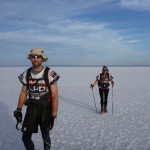 Leg 4 was another long flat leg of bull dust and salt bush. Finding the navigation simple we set a fast pace to head into the next transition. It was a relief to be free of the monotony and lethargy of the salt lake, and we raced through the night regaining some lost time in the cool dry conditions.
Leg 4 was another long flat leg of bull dust and salt bush. Finding the navigation simple we set a fast pace to head into the next transition. It was a relief to be free of the monotony and lethargy of the salt lake, and we raced through the night regaining some lost time in the cool dry conditions.
The following leg was a formidable one. It was a 40 Km trek over three small mountain ranges with some difficult navigation on almost featureless plains. Deciding we had nothing to lose we forced our swollen pulped feet into running shoes and set off. I was eager to get as much done in the light of day as we could, knowing that the navigation got harder and harder the further west we went. Our progress was slow – no more than about 2 Km/h – but it was constant. As we hobbled through the day we picked up several more checkpoints before arriving at a water drop.
Here we donned lights, drank deep and prepared ourselves for the hardest navigation of the course. We set off at our slow deliberate pace, Bec slowed a little by her wrecked feet and a new pain developing in her thigh. We wound our way up dry creek beds, paying careful attention to the match of creek direction and map direction. Then we traversed several slopes to a series of mountain tops before coming to our checkpoint in a saddle. Following a crude bearing we then worked our way to a highpoint, then a wide river bed then up several more creek beds to where I thought our next check point would be but after 2 hours of searching it couldn’t be found. Till now my navigation had been solid as the team’s sole navigator I felt Id done well but now, lost in the wilderness it felt like I was wasting everybody’s time. We agreed that we’d sleep for 2 hours and head off just prior to sunrise in search of the mystery checkpoint. The night was clear and cold. We spooned for warmth, shivering beneath a stunning black moonless sky. After 2 hours of frigid rest we roused just prior to sunrise. We found the checkpoint only a little way north, before we headed into Blilnman – population 22 – for the next TA.
Here we redressed our deteriorating feet and prepared for a straight forward mountain bike. But the trek had damaged our feet more than we could have imagined. Roland and Dan had to cut large swathes of fabric from their bike shoes in order to accommodate their feet. Furious at the imposition, unrelenting agony and the sense of wasted time, Roland set off at a furious pace with Bec on tow. For 30 minutes we set a maniacal pace down bitumen before heading onto some 40kms of dirt on our way into the famous Wilpena. We slowed our pace out of necessity to something more manageable as the heat overtook us and Roland calmed. The next few hours saw us blitz some 7 teams in the space of several hours as we cruised into Wilpena in one of the fastest times in the field. It became the hallmark feature of our race. Fast bike legs followed by agonisingly slow trekking legs.
At Wilpena we wasted time in setting off for the spectacular trek up St. Mary’s peak. It was a relatively straight forward 28km trek on formed paths but we were reluctant none-the-less. Our feet Becs and mine especially were excruciatingly sore. We set off via the public toilets – relishing the chance to use a proper toilet for the first time in 4 days. The trek itself was a slow wander through Wilpena pound. Being night we missed the views, catching instead an ink-black sky, littered with a thousand stars, unadulterated by the pale touch of moonlight. Exhaustion was evident. Roland had begun to hallucinate, seeing faces and animals on the track, and Dan was literally falling asleep on his feet. At times he would lurch to one side, as he almost fell asleep while walking.
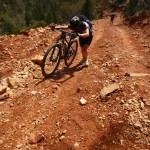 As the track climbed and fell it became evident that Bec was struggling. We stopped for a brief rest, and took extra weight from Bec. Stoic as ever though she was keen to push on, at times even attempting a horrible deranged hobbling run. With less than 10 Kms to the TA we would normally have jogged it in 1.5 hours, however as the pain and lethargy overtook us we found it taking us more than double that. From time to time Bec was doubled over, vomiting in pain. Even though we had done all we could, leaving Bec with less than a kilogram of weight to carry, I couldn’t help but feel useless – unable to help a faultering team mate.
As the track climbed and fell it became evident that Bec was struggling. We stopped for a brief rest, and took extra weight from Bec. Stoic as ever though she was keen to push on, at times even attempting a horrible deranged hobbling run. With less than 10 Kms to the TA we would normally have jogged it in 1.5 hours, however as the pain and lethargy overtook us we found it taking us more than double that. From time to time Bec was doubled over, vomiting in pain. Even though we had done all we could, leaving Bec with less than a kilogram of weight to carry, I couldn’t help but feel useless – unable to help a faultering team mate.
Pushing on to the next transition was a pretty gutsy effort on Bec’s part, and it was a huge relief to get to the transition knowing we had done the majority of the trekking. We took 2 hours of sleep in the early morning then jumped on the bikes for a short sprint to a roping section 400m above the ground. We made short work of the 20kms overtaking several teams along the way. From there we headed up to Moonarie, a world renowned rock climbing area, where we ascended ropes to the next checkpoint. It was a brilliant setting. Dangling high on a vertical, almost overhanging wall of blank red rock, I relished the outrageous exposure and spectacular panorama. Despite our position, I felt as calm and relaxed as I had for the whole race. No stranger to rope-work, it was a delight to be free of the bike and trekking poles, if only for a while.
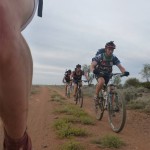 The final push to mid camp was tiring. We pushed hard, knowing that so long as we were on the bike, we were capable of splits in the top 3. It was an exhausting leg though. After several more flats, we came to a steep hike-a-bike. Overcome with the pain in my feet I lagged behind the team as I slowed considerably. In the end Roland had to carry my bike the final few hundred meters up the hill, while I suffered as silently as I could on the ascent. The stiff soles of my bike shoes had slowed me to a crawl, and I felt guilty at holding my team mates up. The roads that made up the following legs didn’t match the maps particularly well at all. From here we bashed our way across country to the next checkpoint, before finding the trail again. After several hours we arrived at Hawker. Here we had a compulsory 6 hr stop. We ate, recharged batteries and attempted to sleep in the baking afternoon sun. Overcome with flies and heat, sleep was a long time coming. We woke at around 8pm to re-dress our feet and head off on a 150km mountain bike leg to Wilmington. Our timing had been a mixed bag. Though we lost sleep in the middle of the day, languishing in our hot windless tent, we were now riding during the cool of night, meaning we had to carry less water and would be less likely to succumb to heat stroke.
The final push to mid camp was tiring. We pushed hard, knowing that so long as we were on the bike, we were capable of splits in the top 3. It was an exhausting leg though. After several more flats, we came to a steep hike-a-bike. Overcome with the pain in my feet I lagged behind the team as I slowed considerably. In the end Roland had to carry my bike the final few hundred meters up the hill, while I suffered as silently as I could on the ascent. The stiff soles of my bike shoes had slowed me to a crawl, and I felt guilty at holding my team mates up. The roads that made up the following legs didn’t match the maps particularly well at all. From here we bashed our way across country to the next checkpoint, before finding the trail again. After several hours we arrived at Hawker. Here we had a compulsory 6 hr stop. We ate, recharged batteries and attempted to sleep in the baking afternoon sun. Overcome with flies and heat, sleep was a long time coming. We woke at around 8pm to re-dress our feet and head off on a 150km mountain bike leg to Wilmington. Our timing had been a mixed bag. Though we lost sleep in the middle of the day, languishing in our hot windless tent, we were now riding during the cool of night, meaning we had to carry less water and would be less likely to succumb to heat stroke.
Ultimately the leg was fairly uneventful. Our feet performed well on the bike legs, and during this leg in particular, navigation was straight forward. We pushed through only slightly slower than the winning team – mountain designs. Just before sunrise I bonked. My legs and body were shot from the 300kms of riding thus far. Somehow though, the sun started a revival, and an hour later I was firing on all cylinders again. Then only 5kms out from the transition Dan began passing out – almost collapsing mid-ride. Dans engine was unique. He literally required calories every 10 minutes. Despite weighing a paltry 60kgs, he ate more than any of us. It took some fine tuning, but in the end he found a winning formula in the form of Hammer Perpetuem solids: small chalky puks worth 33 calories a pop. One of these every 10 minutes while riding seemed to keep him in remarkable shape. During our 450+ Kms of riding, Dan towed Bec for about 300 of them! We took a few minutes out before pushing on to Willmington.
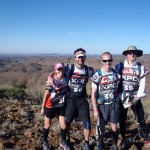 Here we learnt that fierce winds had cancelled the final leg – an 87 Km paddle. Instead a 60 Km mountain bike replaced the final 2 legs. It was a bittersweet ending. Paddling was one of the legs that defined adventure racing. Not paddling felt like cheating. But paddling was also our weakest link, meaning that we had a chance to make up a spot or two in the final leg.
Here we learnt that fierce winds had cancelled the final leg – an 87 Km paddle. Instead a 60 Km mountain bike replaced the final 2 legs. It was a bittersweet ending. Paddling was one of the legs that defined adventure racing. Not paddling felt like cheating. But paddling was also our weakest link, meaning that we had a chance to make up a spot or two in the final leg.
Before that however, the final 50km trekking leg remained – a wandering course through the foothills of Mt Remarkable, then up and over Mt Remarkable itself and down into the small town of Melrose. We resumed our 2kmph pace again picking up several easy checkpoints along the way. All the while we were chowing down on anti-inflamatories and pain killers at maximum dose. As night fell Dan, Roland and Bec began to falter, they stumbled along talking about the snakes on the ground and lights in the trees. Not for the first time this race Roland was hallucinating from tiredness. We bunked down for 2 hours at Scarfes hut. We simply couldn’t justify any more sleep this close to the finish. Heading off again we ascended a 5km ridgeline to a small plateau and the final off-track checkpoint, hidden in a creek bed. Becs feet and leg were ailing, and at times Dan and I had to physically carry her while Roland carried the extra gear. Slung between us we would carry Bec down hills in order to speed up the team.
Roland and Bec were doing it tough though, and as we wandered across a high plateau beneath the summit of Mt Remarkable they began literally falling asleep on their feet. Roland would sway dangerously, while Bec, supported by Dan had her eyes closed, staggering through the undergrowth. At one stage she admitted not remembering the previous hour despite picking up one of our final checkpoints. Struggling to stay awake and to move fast Dan carried Bec for the remaining parts of the 50km trek in an attempt to speed up our progress.
But we were still painfully slow, and 15kms from the end of the trek we found ourselves caught out in the very early hours of the morning. High on the trek, the usually hot weather took a surprising turn, pelting us with strong winds and rain. With people near collapse and hypothermia a real possibility we pushed on to a shelter where we slept for 3 more hours. We spooned for warmth, our mandatory 400 g sleeping bags simply not cutting it in 5 degrees and wet. As the sun dawned we put on wet clothing, ate as much as we could and trekked the final few Kms to Melrose.
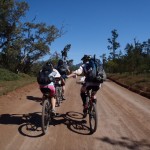 We were one leg from the end. A 60 Km bike ride on bitumen. At the transition we discovered we were an hour behind Team Goldfish and 2 hours behind The Muppets. Backing our biking abilities we hurried to catch them. 20 minutes after arriving we hit the tarmac with blistering pace. We set a pace line and pushed hard. We had to make up about 15kms in a 60kms leg just to make up one place! After a frantic 3 hours we did it. We caught Team Goldfish on the outskirts of Port Augusta and hurried to the finish line.
We were one leg from the end. A 60 Km bike ride on bitumen. At the transition we discovered we were an hour behind Team Goldfish and 2 hours behind The Muppets. Backing our biking abilities we hurried to catch them. 20 minutes after arriving we hit the tarmac with blistering pace. We set a pace line and pushed hard. We had to make up about 15kms in a 60kms leg just to make up one place! After a frantic 3 hours we did it. We caught Team Goldfish on the outskirts of Port Augusta and hurried to the finish line.
No sooner had we overtaken them, than the guilt of pipping someone at the post after 750kms – for 9th place no less overtook us. We stopped on a corner and waited for Goldfish to arrive. Then at last we crossed the finish line as two teams. Exchanging much deserved congratulations.
In the days following our feet have undergone an odd metamorphosis. For my part the pain of walking subsided as flaps of skin dried up and fell off. Sleep calls me all day long. My body wants nothing more than to lie down and rest. But it will subside. And I know that soon I’ll be training again, desperately hanging out for the next race.
Side bar:
 LAKE FROME IS A SALT LAKE THAT FILLS ONCE EVERY 30 ODD YEARS. THERE WAS A SMALL STRIP OF ANKLE-DEEP, HYPER-SALINE WATER AT THE SOUTHERN EDGE, BUT FOR THE MOST PART IT WAS BONE DRY. THE SURFACE WAS A ROCK-HARD SALT CRUST THAT WAS DEAD FLAT. THE CONDITIONS WERE SO HARSH THAT NO PLANT-LIFE, ANIMALS OR INSECTS CAN LIVE ON OR AROUND THE LAKE.
LAKE FROME IS A SALT LAKE THAT FILLS ONCE EVERY 30 ODD YEARS. THERE WAS A SMALL STRIP OF ANKLE-DEEP, HYPER-SALINE WATER AT THE SOUTHERN EDGE, BUT FOR THE MOST PART IT WAS BONE DRY. THE SURFACE WAS A ROCK-HARD SALT CRUST THAT WAS DEAD FLAT. THE CONDITIONS WERE SO HARSH THAT NO PLANT-LIFE, ANIMALS OR INSECTS CAN LIVE ON OR AROUND THE LAKE.


